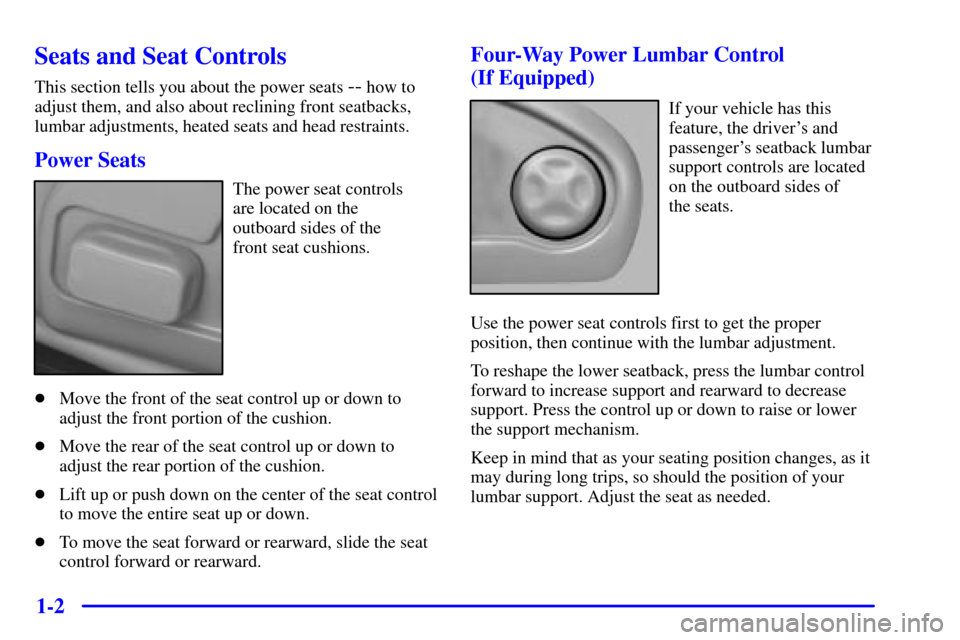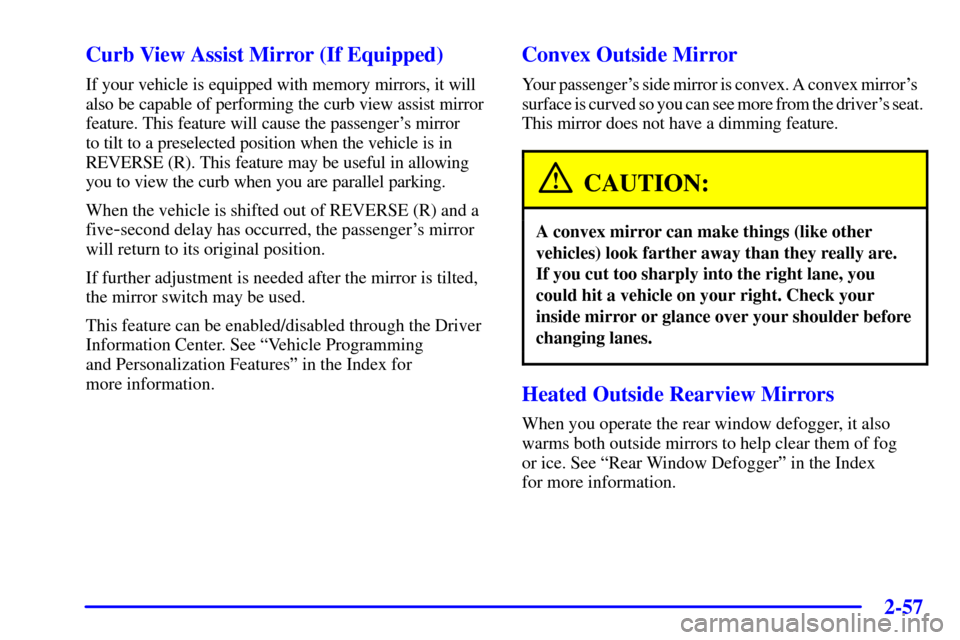Page 8 of 399

1-2
Seats and Seat Controls
This section tells you about the power seats -- how to
adjust them, and also about reclining front seatbacks,
lumbar adjustments, heated seats and head restraints.
Power Seats
The power seat controls
are located on the
outboard sides of the
front seat cushions.
�Move the front of the seat control up or down to
adjust the front portion of the cushion.
�Move the rear of the seat control up or down to
adjust the rear portion of the cushion.
�Lift up or push down on the center of the seat control
to move the entire seat up or down.
�To move the seat forward or rearward, slide the seat
control forward or rearward.
Four-Way Power Lumbar Control
(If Equipped)
If your vehicle has this
feature, the driver's and
passenger's seatback lumbar
support controls are located
on the outboard sides of
the seats.
Use the power seat controls first to get the proper
position, then continue with the lumbar adjustment.
To reshape the lower seatback, press the lumbar control
forward to increase support and rearward to decrease
support. Press the control up or down to raise or lower
the support mechanism.
Keep in mind that as your seating position changes, as it
may during long trips, so should the position of your
lumbar support. Adjust the seat as needed.
Page 9 of 399
1-3 Memory Seat, Mirrors and Steering
Wheel (Option)
The controls for these
features are located on
the driver's door panel.These buttons are used to program and recall memory
settings for the driver's seating and outside rearview
mirror positions. Use the following steps to program
each button:
1. Adjust the driver's seat (including the seatback
recliner, lumbar, head restraint and shoulder belt
height adjustments), both outside mirrors and the
steering wheel to a comfortable position.
2. Press the SET button.
3. Within five seconds, press button 1 for Driver 1.
A single beep will sound through the driver's side
front speaker to let you know that the position has
been stored.
Page 114 of 399

2-57 Curb View Assist Mirror (If Equipped)
If your vehicle is equipped with memory mirrors, it will
also be capable of performing the curb view assist mirror
feature. This feature will cause the passenger's mirror
to tilt to a preselected position when the vehicle is in
REVERSE (R). This feature may be useful in allowing
you to view the curb when you are parallel parking.
When the vehicle is shifted out of REVERSE (R) and a
five
-second delay has occurred, the passenger's mirror
will return to its original position.
If further adjustment is needed after the mirror is tilted,
the mirror switch may be used.
This feature can be enabled/disabled through the Driver
Information Center. See ªVehicle Programming
and Personalization Featuresº in the Index for
more information.
Convex Outside Mirror
Your passenger's side mirror is convex. A convex mirror's
surface is curved so you can see more from the driver's seat.
This mirror does not have a dimming feature.
CAUTION:
A convex mirror can make things (like other
vehicles) look farther away than they really are.
If you cut too sharply into the right lane, you
could hit a vehicle on your right. Check your
inside mirror or glance over your shoulder before
changing lanes.
Heated Outside Rearview Mirrors
When you operate the rear window defogger, it also
warms both outside mirrors to help clear them of fog
or ice. See ªRear Window Defoggerº in the Index
for more information.
Page 322 of 399

6-41
The vehicle should be properly prepared as follows:
�The vehicle should be placed so the headlamps
are 25 ft. (7.6 m) from a light colored wall or other
flat surface.
�The vehicle must have all four tires on a perfectly
level surface which is level all the way to the wall or
other flat surface.
�The vehicle should be placed so it is perpendicular to
the wall or other flat surface.
�The vehicle should not have any snow, ice or mud
attached to it.
�The vehicle should be fully assembled and all other
work stopped while headlamp aiming is being done.
�The vehicle should be normally loaded with a full
tank of fuel and one person or 160 lbs. (75 kg) on
the driver's seat.
�Tires should be properly inflated.
�Start the vehicle and rock it to level the suspension.
Headlamp aiming is done with the vehicle low beam
lamps. The high beam lamps will be correctly aimed if
the low beam lamps are aimed properly.The headlamp aiming devices are under the hood near
the headlamps.
If you believe your headlamps need horizontal
(left/right) adjustment, follow the horizontal aiming
procedure. If you believe your headlamps need only
vertical (up/down) adjustment, follow only the vertical
aiming procedure.
Adjustment screws can be turned with an E8 Torx
�
socket or T15 Torx screwdriver.